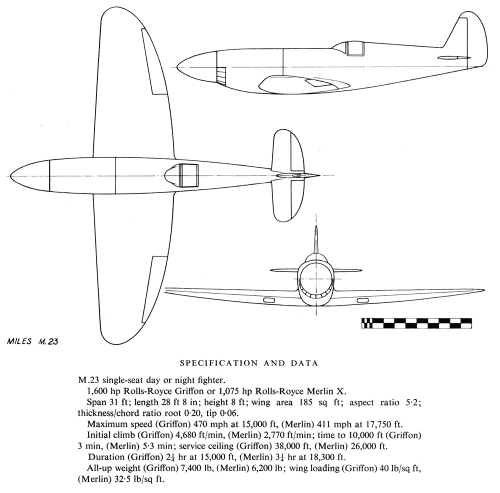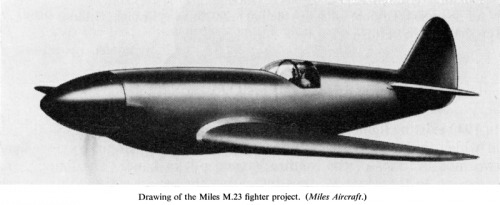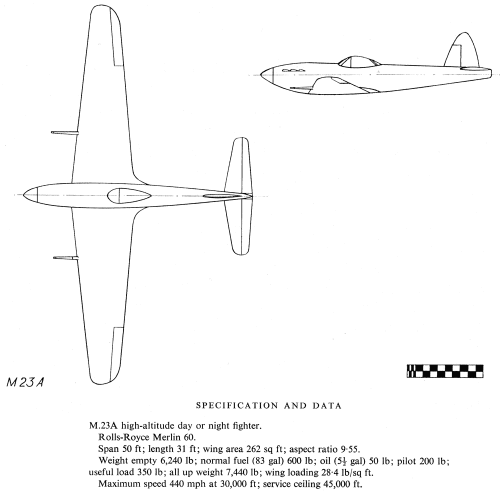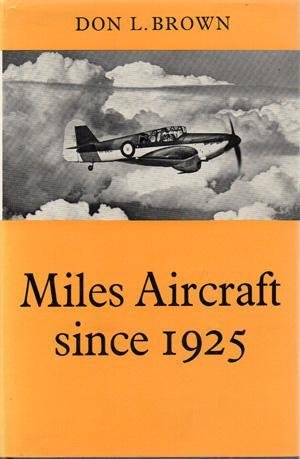blackkite
Don't laugh, don't cry, don't even curse, but.....
- Joined
- 31 May 2007
- Messages
- 8,297
- Reaction score
- 5,904
Hi! Miles M23.
http://beyondthesprues.com/Forum/index.php?topic=4178.0
"M.23 Fighter Projects
In 1941 a proposal was submitted to the Ministry of Aircraft Production for a high-speed single-seat fighter powered initially by a Rolls-Royce
Merlin engine, then in full production, and later by a more powerful Rolls-Royce Griffon as soon as it became available. The aircraft was of
wood construction with the exception of the wing spars, which were of metal. It was fitted with a reversed tricycle undercarriage, the rear unit
of which was provided with two positions, giving either a horizontal or a taildown attitude to the fuselage. The main undercarriage units folded
inwards into the wings, giving a wide track.
In order to reduce frontal area, the windscreen and canopy were very low indeed. To enable the pilot to have adequate view for take-off and
landing, he could raise his seat, the top of the canopy hinging up to form a windscreen as in the Master. The wing was of elliptical planform, the
root thickness being 0.2c. Armament consisted of eight .303 Browning guns together with 500 rounds of ammunition per gun instead of the 300
provided on contemporary fighters. Alternatively, two 20 mm Hispano-Suiza cannon could be fitted. The wing area was substantially less than on existing fighters, being only 185 sq ft as compared with 242 on the Spitfire and 258 on the Hurricane, and the wing loading was accordingly higher. The M.23 was not ordered, possibly because it was of wooden construction and possibly because the Ministry did not believe that, even with a Griffon engine, a speed of 470 mph would be attainable with a 20 percent thick wing.
- Miles Aircraft since 1925, Don L. Brown, Putnam 1970"
"M.23A
In 1942 existing fighters were finding difficulty in reaching the high altitude at which the Junkers-Ju 86s were operating. As a temporary expedient, two modifications of the Spitfire V were put in hand. The first was an extension to the wingtips, thus increasing the aspect ratio with a corresponding decrease in induced drag especially at low indicated air speeds, and consequent increase in ceiling. This variant was known as the Spitfire VII. The other was the use of a more powerful version of the Merlin engine, installed in the Spitfire IX.
It was felt, however, that a pressurized high-altitude fighter should be put in hand as quickly as possible. The author prepared a project design,
the M.23A, using the then new Rolls-Royce Merlin 60 engine which had -a greatly increased rated height. The ducted radiators were mounted in
the wing, inboard of the cannon, and the armament consisted of two 20 mm cannon with 60 rounds of shells per cannon. In addition, extra
fuel was carried in jettisonable tanks, thus increasing the operational range without impairing the high-altitude performance. On account of
the very high aspect ratio employed, the span loading was very much better than that of the Spitfire or even than the Westland Welkin, a twin
engined fighter designed specifically for high-altitude operation. The M.23A was the first Miles project with a thin high aspect ratio wing, but
it was never ordered.
- Miles Aircraft since 1925, Don L. Brown, Putnam 1970"
http://beyondthesprues.com/Forum/index.php?topic=4178.0
"M.23 Fighter Projects
In 1941 a proposal was submitted to the Ministry of Aircraft Production for a high-speed single-seat fighter powered initially by a Rolls-Royce
Merlin engine, then in full production, and later by a more powerful Rolls-Royce Griffon as soon as it became available. The aircraft was of
wood construction with the exception of the wing spars, which were of metal. It was fitted with a reversed tricycle undercarriage, the rear unit
of which was provided with two positions, giving either a horizontal or a taildown attitude to the fuselage. The main undercarriage units folded
inwards into the wings, giving a wide track.
In order to reduce frontal area, the windscreen and canopy were very low indeed. To enable the pilot to have adequate view for take-off and
landing, he could raise his seat, the top of the canopy hinging up to form a windscreen as in the Master. The wing was of elliptical planform, the
root thickness being 0.2c. Armament consisted of eight .303 Browning guns together with 500 rounds of ammunition per gun instead of the 300
provided on contemporary fighters. Alternatively, two 20 mm Hispano-Suiza cannon could be fitted. The wing area was substantially less than on existing fighters, being only 185 sq ft as compared with 242 on the Spitfire and 258 on the Hurricane, and the wing loading was accordingly higher. The M.23 was not ordered, possibly because it was of wooden construction and possibly because the Ministry did not believe that, even with a Griffon engine, a speed of 470 mph would be attainable with a 20 percent thick wing.
- Miles Aircraft since 1925, Don L. Brown, Putnam 1970"
"M.23A
In 1942 existing fighters were finding difficulty in reaching the high altitude at which the Junkers-Ju 86s were operating. As a temporary expedient, two modifications of the Spitfire V were put in hand. The first was an extension to the wingtips, thus increasing the aspect ratio with a corresponding decrease in induced drag especially at low indicated air speeds, and consequent increase in ceiling. This variant was known as the Spitfire VII. The other was the use of a more powerful version of the Merlin engine, installed in the Spitfire IX.
It was felt, however, that a pressurized high-altitude fighter should be put in hand as quickly as possible. The author prepared a project design,
the M.23A, using the then new Rolls-Royce Merlin 60 engine which had -a greatly increased rated height. The ducted radiators were mounted in
the wing, inboard of the cannon, and the armament consisted of two 20 mm cannon with 60 rounds of shells per cannon. In addition, extra
fuel was carried in jettisonable tanks, thus increasing the operational range without impairing the high-altitude performance. On account of
the very high aspect ratio employed, the span loading was very much better than that of the Spitfire or even than the Westland Welkin, a twin
engined fighter designed specifically for high-altitude operation. The M.23A was the first Miles project with a thin high aspect ratio wing, but
it was never ordered.
- Miles Aircraft since 1925, Don L. Brown, Putnam 1970"




